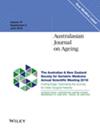Associations of Handgrip Strength and Body Mass Index With All-Cause Mortality: A 14-Year Follow-Up of the Korea Longitudinal Study of Aging
Abstract
Objective
The associations of handgrip strength and body mass index (BMI) with mortality vary across age groups. This study aimed to investigate whether these associations differ between middle-aged and older adults in the Korean population. Additionally, we assessed whether handgrip strength had the potential to affect the relationship between obesity and mortality.
Methods
A total of 9311 individuals aged 45–84 years from the Korean Longitudinal Study on Aging were followed up for 14 years. Hazard ratios for all-cause mortality were estimated separately for the middle-aged (less than 65 years) and older (65 years or older) groups using age- and sex-specific tertiles of handgrip strength and Korean obesity criteria.
Results
The relationships between handgrip strength or BMI with mortality did not materially differ across age groups. Both age groups exhibited the highest mortality rates among the individuals with low handgrip strength or a BMI < 18.5 kg/m2. Conversely, the lowest mortality was found in those with high handgrip strength or a BMI from 23.0 to 29.9 kg/m2. When stratified by handgrip strength, the BMI level associated with the lowest mortality risk shifted towards a higher BMI category in the low-strength group compared to the high-strength group.
Conclusions
While the associations between handgrip strength, BMI and mortality were similar across age groups, the pattern of the BMI–mortality relationship was clearly modified by handgrip strength. This suggests that muscle strength should be considered when evaluating the health risks of obesity.


 求助内容:
求助内容: 应助结果提醒方式:
应助结果提醒方式:


